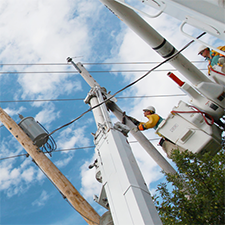Contractors and First Responders – Overhead Lines

Follow our guidelines for working on or near overhead power lines to minimize your risk of electrocution or other serious injury.
Always keep a safe distance
Maintain a distance of at least 20 feet between overhead power lines and yourself and all your equipment. This includes everything from your tools to scaffolding to vehicles and other heavy machinery. Never store your equipment near or under power lines.
Contact us before you work around or near power lines
Make sure we’re aware of your project before you start working, as not all power lines can be de-energized. We assess each case and will de-energize and ground the power line if possible. We can also cover lines as means of warning to the proximity of an energized power line that should not be contacted or encroached upon.
Watch out for the wires supporting utility poles
Be careful your equipment does not snap the guy wires, the angled cables connecting the top of utility poles to the ground. Damaging a guy wire could cause the overhead power lines to sag, which might prevent you from safely passing underneath the line.
Always use a spotter when moving or operating equipment near the lines
Spotters can monitor the clearance between the line and equipment – such as ladders, scaffolding, cranes, etc. – and can alert the team if equipment gets too close. Designated spotters should focus only on this role and not perform any other tasks while equipment is being moved or operated near hazardous conditions like power lines.
What to do if your equipment comes into contact with a power line
Always assume the line is active. No one should come near or touch the equipment or machine. Maintain a safe distance and call us immediately for assistance.
How to safely exit equipment in an emergency
Do your best to jump completely clear without ever touching the equipment and the ground at the same time. Land with both feet together and keep them together. Shuffle away from the equipment in small steps, keeping both feet flat on the ground as you do so. This reduces your risk of electrical shock.
Contact us before you work around or near power lines
Make sure we’re aware of your project before you start working, as not all power lines can be de-energized. We assess each case and will de-energize and ground the power line if possible. We can also cover lines as means of warning to the proximity of an energized power line that should not be contacted or encroached upon.
Watch out for the wires supporting utility poles
Be careful your equipment does not snap the guy wires, the angled cables connecting the top of utility poles to the ground. Damaging a guy wire could cause the overhead power lines to sag, which might prevent you from safely passing underneath the line.
Always use a spotter when moving or operating equipment near the lines
Spotters can monitor the clearance between the line and equipment – such as ladders, scaffolding, cranes, etc. – and can alert the team if equipment gets too close. Designated spotters should focus only on this role and not perform any other tasks while equipment is being moved or operated near hazardous conditions like power lines.
What to do if your equipment comes into contact with a power line
Always assume the line is active. No one should come near or touch the equipment or machine. Maintain a safe distance and call us immediately for assistance.
How to safely exit equipment in an emergency
Do your best to jump completely clear without ever touching the equipment and the ground at the same time. Land with both feet together and keep them together. Shuffle away from the equipment in small steps, keeping both feet flat on the ground as you do so. This reduces your risk of electrical shock.
Review digging safety information or view our training resources.